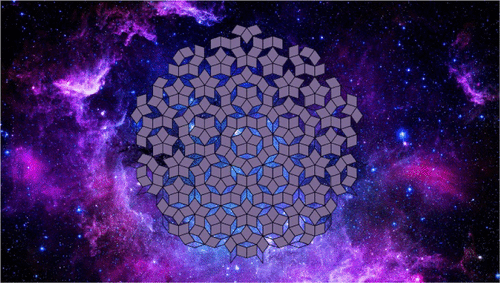当前位置:
X-MOL 学术
›
ACS Earth Space Chem.
›
论文详情
Our official English website, www.x-mol.net, welcomes your
feedback! (Note: you will need to create a separate account there.)
Trace Element Conundrum of Natural Quasicrystals
ACS Earth and Space Chemistry ( IF 2.9 ) Pub Date : 2021-02-25 , DOI: 10.1021/acsearthspacechem.1c00004 Simone Tommasini 1 , Luca Bindi 1, 2 , Maurizio Petrelli 3, 4 , Paul D. Asimow 5 , Paul J. Steinhardt 6
ACS Earth and Space Chemistry ( IF 2.9 ) Pub Date : 2021-02-25 , DOI: 10.1021/acsearthspacechem.1c00004 Simone Tommasini 1 , Luca Bindi 1, 2 , Maurizio Petrelli 3, 4 , Paul D. Asimow 5 , Paul J. Steinhardt 6
Affiliation

|
We report laser ablation inductively coupled plasma mass spectrometry measurements of the trace element contents of the two naturally occurring quasicrystalline minerals, Al63Cu24Fe13 icosahedrite and Al71Ni24Fe5 decagonite, from their type locality in the Khatyrka meteorite. The isolated quasicrystal fragments were mounted separately from any matrix and are larger than the laser beam diameter. When the elements are sorted in order of volatility, a systematic and unique pattern emerges in both bulk natural quasicrystal specimens. They are highly depleted compared to primitive solar system materials (chondritic meteorites) in moderately refractory elements (those with 50% condensation temperatures near 1350–1300 K; V, Co, Mg, Cr) and significantly enriched in moderately volatile elements (those with 50% condensation temperatures between 1250 and 500 K; Sb, B, Ag, Sn, Bi). We compare the chondrite-normalized trace element patterns and ratios of the quasicrystals to those of scoriaceous cosmic spherules and other meteoritic components. The nonmonotonic shapes of the chondrite-normalized trace element patterns in both icosahedrite and decagonite are incompatible with a single condensation process from the gas of the solar nebula. Previous transmission electron microscopy studies show that the natural quasicrystals contain 3–5 vol % of silicate and oxide nanoparticle inclusions, which we consider to be the main host of the measured trace elements. On this basis, we construct a three-stage model for the formation of the quasicrystals and their inclusions: a high-temperature condensation stage and a low-temperature vapor-fractionation stage to make nanoparticles, followed by a third stage that leads to the formation of quasicrystals incorporating the two different types of nanoparticles and their incorporation into the CV chondrite parent body of the Khatyrka meteorite.
中文翻译:

天然准晶体的微量元素难题
我们报告了两种天然存在的准晶体矿物Al 63 Cu 24 Fe 13二十面体和Al 71 Ni 24 Fe 5的痕量元素含量的激光烧蚀电感耦合等离子体质谱测量。钙钛矿,从其类型分布在Khatyrka陨石中。分离的准晶体碎片与任何基质分开安装,并且大于激光束直径。当元素按挥发度排序时,两个散装的天然准晶体样品中都出现了系统且独特的图案。与原始太阳系材料(粒状陨石)相比,它们在中等耐火元素(冷凝温度在1350–1300 K附近具有50%的那些; V,Co,Mg,Cr的那些)中的贫乏,并在中等挥发性元素(含50的那些中显着富集) %冷凝温度在1250和500 K之间; Sb,B,Ag,Sn,Bi)。我们比较了球墨铸铁规范化的痕量元素图案和准晶体与针状宇宙球和其他陨石成分的比率。二十面体和十方体中球粒陨石归一化痕量元素图案的非单调形状与来自太阳星云气体的单一凝结过程不兼容。先前的透射电子显微镜研究表明,天然准晶体包含3–5%(体积)的硅酸盐和氧化物纳米颗粒夹杂物,我们认为它们是所测痕量元素的主要基质。在此基础上,我们为准晶体及其包裹体的形成建立了一个三阶段模型:一个高温冷凝阶段和一个低温蒸汽分馏阶段以制备纳米颗粒,然后是第三阶段以导致形成纳米颗粒。结合了两种不同类型的纳米粒子的准晶体,并将其结合到Khatyrka陨石的CV球粒陨石母体中。
更新日期:2021-03-18
中文翻译:

天然准晶体的微量元素难题
我们报告了两种天然存在的准晶体矿物Al 63 Cu 24 Fe 13二十面体和Al 71 Ni 24 Fe 5的痕量元素含量的激光烧蚀电感耦合等离子体质谱测量。钙钛矿,从其类型分布在Khatyrka陨石中。分离的准晶体碎片与任何基质分开安装,并且大于激光束直径。当元素按挥发度排序时,两个散装的天然准晶体样品中都出现了系统且独特的图案。与原始太阳系材料(粒状陨石)相比,它们在中等耐火元素(冷凝温度在1350–1300 K附近具有50%的那些; V,Co,Mg,Cr的那些)中的贫乏,并在中等挥发性元素(含50的那些中显着富集) %冷凝温度在1250和500 K之间; Sb,B,Ag,Sn,Bi)。我们比较了球墨铸铁规范化的痕量元素图案和准晶体与针状宇宙球和其他陨石成分的比率。二十面体和十方体中球粒陨石归一化痕量元素图案的非单调形状与来自太阳星云气体的单一凝结过程不兼容。先前的透射电子显微镜研究表明,天然准晶体包含3–5%(体积)的硅酸盐和氧化物纳米颗粒夹杂物,我们认为它们是所测痕量元素的主要基质。在此基础上,我们为准晶体及其包裹体的形成建立了一个三阶段模型:一个高温冷凝阶段和一个低温蒸汽分馏阶段以制备纳米颗粒,然后是第三阶段以导致形成纳米颗粒。结合了两种不同类型的纳米粒子的准晶体,并将其结合到Khatyrka陨石的CV球粒陨石母体中。











































 京公网安备 11010802027423号
京公网安备 11010802027423号